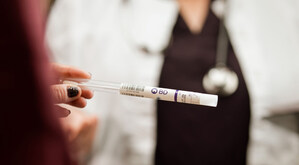Resource Now Available to Help Clinicians Reduce Risk of Blood Exposure from Short Peripheral IV Catheter Insertion
BD Launches Making Safety Safer(SM) Campaign
SANDY, Utah, May 3, 2011 /PRNewswire/ -- Healthcare workers now have the ability to better identify risks for exposure to bloodborne pathogens, take precautions to better protect themselves, and share information and experiences as a result of a new program developed by BD Medical, a segment of BD (Becton, Dickinson and Company) and the world's leading provider of IV catheters.
The BD Making Safety Safer(SM) program will provide nurses and other healthcare professionals with a forum to share information on risks, precautions and interventions, learn from experts and peers, and assist hospitals and other healthcare organizations in addressing ongoing concerns relating to blood exposure due to insertion of a short peripheral IV catheter (SPIVC).
Cheryll Collins, BSN, RN, OCN was exposed to blood from a patient infected with HIV and Hepatitis C. "As I unhooked the [needle] chamber, the patient pulled her arm away. The blood that was left in the hub went straight across my face and into my eye," said Collins. "That incident had a profound impact on my life, as well the lives of my husband and family." To view a video of her personal story, visit www.bd.com/bloodcontrol.
"Although the healthcare industry has come a long way in reducing the risk of needlestick injuries and their potential dangers, mucocutaneous blood exposure during a short peripheral IV catheter insertion is still a risk today," said John Ledek, Vice President, BD Medical - Medical Surgical Systems. "BD created this educational resource to enable clinicians to better protect themselves."
This program will help educate nurses to approach short peripheral IV insertion with more caution, such as using appropriate personal protective equipment and taking other appropriate precautions to better protect themselves from contaminated blood.
BD also is sponsoring online forums on blood safety and inviting clinicians to learn and share their experiences. Visit www.bd.com/bloodcontrol to access these resources online.
SPIVCs are the most commonly used device to access a patient's blood vessels. Blood exposure, including exposure that may occur upon insertion of an SPIVC, presents a risk to clinicians and patients. According to multiple published studies, up to 37.8 percent of healthcare workers report having experienced at least one blood or body fluid exposure in the preceding year (1, 2, 3). A recent report from the International Healthcare Worker Safety Center at the University of Virginia shows that nurses are at greatest risk, reporting 48.6 percent of blood or bodily fluid exposures(4).
About BD
BD is a leading global medical technology company that develops, manufactures and sells medical devices, instrument systems and reagents. The Company is dedicated to improving people's health throughout the world. BD is focused on improving drug delivery, enhancing the quality and speed of diagnosing infectious diseases and cancers, and advancing research, discovery and production of new drugs and vaccines. BD's capabilities are instrumental in combating many of the world's most pressing diseases. Founded in 1897 and headquartered in Franklin Lakes, New Jersey, BD employs approximately 29,000 associates in more than 50 countries throughout the world. The Company serves healthcare institutions, life science researchers, clinical laboratories, the pharmaceutical industry and the general public. For more information, please visit www.bd.com.
(1) Doebbeling BN, Vaughn TE, McCoy KD, Beekmann SE, Woolson RF, Ferguson KJ, et al. Percutaneous injury, blood exposure, and adherence to standard precautions: are hospital-based health care providers still at risk? Clin Infect Dis. 2003 Oct 15;37(8):1006-13.
(2) Zhang M, Wang H, Miao J, Du X, Li T, Wu Z. Occupational exposure to blood and body fluids among health care workers in a general hospital, China. Am J Ind Med. 2009 Feb;52(2):89-98.
(3) Tarantola A, Koumare A, Rachline A, Sow PS, Diallo MB, Doumbia S, et al. A descriptive, retrospective study of 567 accidental blood exposures in healthcare workers in three West African countries. J Hosp Infect. 2005 Jul;60(3):276-82.
(4) EPINet. International Healthcare Worker Safety Center, University of Virginia. U.S. Blood and Body Fluid Exposure Report. 2007 [Mar 7, 2011]
Contact: Barbara Kalavik |
Contact: Jennifer Vollaro |
|
BD Public Relations |
Integrated Marketing Services |
|
(201) 847-4209 |
(609) 683-9055 ext. 247 |
|
Barbara_ [email protected] |
||
SOURCE BD (Becton, Dickinson and Company)
WANT YOUR COMPANY'S NEWS FEATURED ON PRNEWSWIRE.COM?
Newsrooms &
Influencers
Digital Media
Outlets
Journalists
Opted In





Share this article